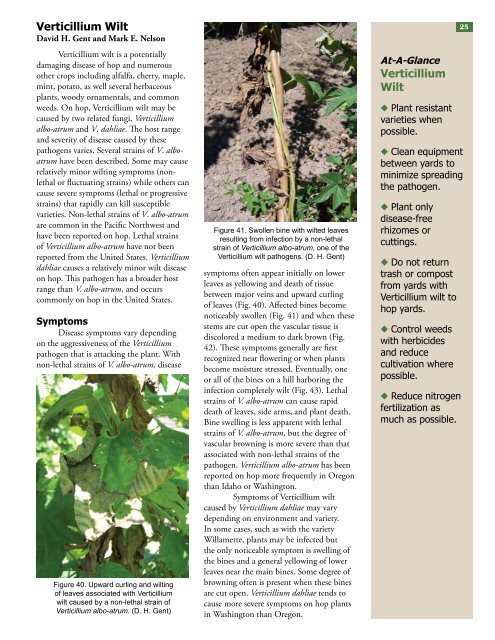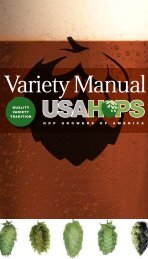Field Guide for Integrated Pest Management in Hops
Field Guide for Integrated Pest Management in Hops
Field Guide for Integrated Pest Management in Hops
You also want an ePaper? Increase the reach of your titles
YUMPU automatically turns print PDFs into web optimized ePapers that Google loves.
Verticillium WiltDavid H. Gent and Mark E. NelsonVerticillium wilt is a potentiallydamag<strong>in</strong>g disease of hop and numerousother crops <strong>in</strong>clud<strong>in</strong>g alfalfa, cherry, maple,m<strong>in</strong>t, potato, as well several herbaceousplants, woody ornamentals, and commonweeds. On hop, Verticillium wilt may becaused by two related fungi, Verticilliumalbo-atrum and V. dahliae. The host rangeand severity of disease caused by thesepathogens varies. Several stra<strong>in</strong>s of V. alboatrumhave been described. Some may causerelatively m<strong>in</strong>or wilt<strong>in</strong>g symptoms (nonlethalor fluctuat<strong>in</strong>g stra<strong>in</strong>s) while others cancause severe symptoms (lethal or progressivestra<strong>in</strong>s) that rapidly can kill susceptiblevarieties. Non-lethal stra<strong>in</strong>s of V. albo-atrumare common <strong>in</strong> the Pacific Northwest andhave been reported on hop. Lethal stra<strong>in</strong>sof Verticillium albo-atrum have not beenreported from the United States. Verticilliumdahliae causes a relatively m<strong>in</strong>or wilt diseaseon hop. This pathogen has a broader hostrange than V. albo-atrum, and occurscommonly on hop <strong>in</strong> the United States.SymptomsDisease symptoms vary depend<strong>in</strong>gon the aggressiveness of the Verticilliumpathogen that is attack<strong>in</strong>g the plant. Withnon-lethal stra<strong>in</strong>s of V. albo-atrum, diseaseFigure 40. Upward curl<strong>in</strong>g and wilt<strong>in</strong>gof leaves associated with Verticilliumwilt caused by a non-lethal stra<strong>in</strong> ofVerticillium albo-atrum. (D. H. Gent)Figure 41. Swollen b<strong>in</strong>e with wilted leavesresult<strong>in</strong>g from <strong>in</strong>fection by a non-lethalstra<strong>in</strong> of Verticillium albo-atrum, one of theVerticillium wilt pathogens. (D. H. Gent)symptoms often appear <strong>in</strong>itially on lowerleaves as yellow<strong>in</strong>g and death of tissuebetween major ve<strong>in</strong>s and upward curl<strong>in</strong>gof leaves (Fig. 40). Affected b<strong>in</strong>es becomenoticeably swollen (Fig. 41) and when thesestems are cut open the vascular tissue isdiscolored a medium to dark brown (Fig.42). These symptoms generally are firstrecognized near flower<strong>in</strong>g or when plantsbecome moisture stressed. Eventually, oneor all of the b<strong>in</strong>es on a hill harbor<strong>in</strong>g the<strong>in</strong>fection completely wilt (Fig. 43). Lethalstra<strong>in</strong>s of V. albo-atrum can cause rapiddeath of leaves, side arms, and plant death.B<strong>in</strong>e swell<strong>in</strong>g is less apparent with lethalstra<strong>in</strong>s of V. albo-atrum, but the degree ofvascular brown<strong>in</strong>g is more severe than thatassociated with non-lethal stra<strong>in</strong>s of thepathogen. Verticillium albo-atrum has beenreported on hop more frequently <strong>in</strong> Oregonthan Idaho or Wash<strong>in</strong>gton.Symptoms of Verticillium wiltcaused by Verticillium dahliae may varydepend<strong>in</strong>g on environment and variety.In some cases, such as with the varietyWillamette, plants may be <strong>in</strong>fected butthe only noticeable symptom is swell<strong>in</strong>g ofthe b<strong>in</strong>es and a general yellow<strong>in</strong>g of lowerleaves near the ma<strong>in</strong> b<strong>in</strong>es. Some degree ofbrown<strong>in</strong>g often is present when these b<strong>in</strong>esare cut open. Verticillium dahliae tends tocause more severe symptoms on hop plants<strong>in</strong> Wash<strong>in</strong>gton than Oregon.At-A-GlanceVerticilliumWilt◆◆Plant resistantvarieties whenpossible.◆◆Clean equipmentbetween yards tom<strong>in</strong>imize spread<strong>in</strong>gthe pathogen.◆◆Plant onlydisease-freerhizomes orcutt<strong>in</strong>gs.◆◆Do not returntrash or compostfrom yards withVerticillium wilt tohop yards.◆◆Control weedswith herbicidesand reducecultivation wherepossible.◆◆Reduce nitrogenfertilization asmuch as possible.25








